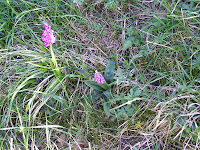Scientific Name: Orchis mascula - 'orchis' is from the Greek for testicle, a reference to the form and arrangement of the tubers; 'mascula' is from the Latin for masculin or virile, a reference both to the underground parts of the plant and to the erect phallic appearance of the eperon at the back of the flower.
English Name: Early Purple Orchid - it does what it says on the tin - it is one of the earliest orchids to flower and the flowers are a strong bright crimson purple colour.
French Name: Orchis mâle - makes the same references as the scientific name. Also called Pentecôte (Pentecost or Whitsun, which falls in May or June 50 days after Easter. O. mascula begins flowering much earlier than this, but it is possible that country people did not recognise that the very similar but slightly later flowering Anacamptis laxiflora was a different species, and called both Pentecôte); Satirion (a much older, pagan name indicating a belief in the plant's aphrodisiac properties based on the form of the tubers and the erect spur at the back of the flower); Soupe à vin (wine soup); Pain de couleuvre (grass snake bread); Mâle fou (madman - an indication that the plant was believed to induce an altered state of consciousness); Couillon de chien (the dog's bollocks).
 5 Key Characters:
5 Key Characters:- the leaves have large blackish violet or brownish spots (rarely without spots).
- the flower spike is densely packed and the flowers are often numerous.
- can form large colonies.
- the flowers are richly coloured magenta, and can range from light purple to violet red, sometimes white or pink.
- the eperon ('tail') is thick, about as long as the flower 'throat', blunt or slightly flattened at the tip and usually points upwards (at least horizontal).
Link to an article in Days on the Claise on how to distinguish between Early Purple and Green-winged Orchids.
Habitat: Full sun to semi-shade; wet to dry, slightly acidic to slightly alkaline (calcareous) soil, generally quite rich, cool and damp; roadsides and embankments, grassy slopes, hay meadows, heathlands, scrub, broadleaf forests (where they always flower before the trees have their leaves), woodland clearings. Almost all the colonies in the Touraine are on roadsides, often forming large populations.
Flowering Period: April-May-June-July. The leaves appear in winter.
Status: Fairly common and can be conspicuous. Can be seen within 5km of Preuilly-sur-Claise. It is one of the most widely distributed orchids, more abundant north of the Loire, but still well represented south of the Loire. It seems to be rarer around Richelieu and Bourgueil. Occurs in the Brenne and the Sologne.
Photographed by Loire Valley Nature:Photographs are numbered from left to right, top to bottom.
1 a roadside colony at Humeau, showing a range of flower colour. 2 leaf rosette. 3 flowering with Cowslips Primula veris.
4 a white flowered specimen at Chanceau-pres-Loches. 5 on the roadside between Preuilly-sur-Claise and le Grand Pressigny. 6-7 on the roadside in the Parc de Boussay.
8-21 roadside colony between Preuilly-sur-Claise and le Grand Pressigny. Note that a number of plants do not have spotted leaves (the leaves in the foreground of 18 are Comfrey Symphytum sp, not orchid leaves).



























I photographed my first orchids of the season yesterday in one of the limestone dales of the Peak District in England.
ReplyDeleteIt's always a thrill to see the first ones. Our season here is just about to start. Only leaf rosettes so far though.
ReplyDelete